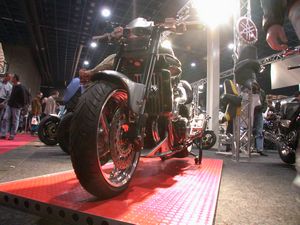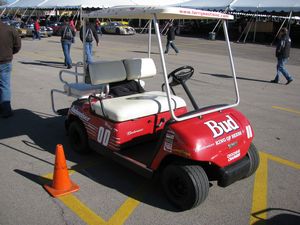















Yamaha |
|---|

|
| Topic Navigation |
|---|
|
Official Site: global.yamaha-motor.com
Wikipedia: Yamaha Motor Company Subtopics Yamaha Owners Club Page Sections History Photographs Documents Article Index |
History
The following section is an excerpt from Wikipedia's Yamaha Motor Company page on 6 May 2017, text available via the Creative Commons Attribution-ShareAlike 3.0 Unported License.
Yamaha Motor Company Limited (ヤマハ発動機株式会社 Yamaha Hatsudōki Kabushiki-gaisha) is a Japanese manufacturer of motorcycles, marine products such as boats and outboard motors, and other motorized products. The company was established in 1955 upon separation from Yamaha Corporation (however Yamaha Corporation is still the largest shareholder with 12.21%, as of June 30, 2014), and is headquartered in Iwata, Shizuoka, Japan. The company conducts development, production and marketing operations through 109 consolidated subsidiaries as of 2012.
Led by Genichi Kawakami, the company’s first president, Yamaha Motor began production of its first product, the YA-1, in 1955. The 125cc motorcycle won the 3rd Mount Fuji Ascent Race in its class.
The company's products includes motorcycles, scooters, motorized bicycles, boats, sail boats, personal water craft, swimming pools, utility boats, fishing boats, outboard motors, 4-wheel ATVs, recreational off-road vehicles, go-kart engines, golf carts, multi-purpose engines, electrical generators, water pumps, snowmobiles, small snow throwers, automobile engines, surface mounters, intelligent machinery, industrial-use unmanned helicopters, electrical power units for wheelchairs and helmets.The company is also involved in the import and sales of various types of products, development of tourist businesses and management of leisure, recreational facilities and related services.motorcycle is the second largest in the world, Outboard motor and water vehicle sales are the world leader
Beginnings: 1955
The motorcycle division of Yamaha was founded in 1955, and was headed by Genichi Kawakami. Yamaha's initial product was a 125cc two-cycle, single cylinder motorcycle, the YA-1, which was a copy of the German DKW RT125. The YA-1 was a competitive success at racing from the beginning, winning not only the 125cc class in the Mt. Fuji Ascent, but also sweeping the podium with first, second and third place in the All Japan Autobike Endurance Road Race that same year. Early success in racing set the tone for Yamaha, as competition in many varieties of motorcycle racing has been a key endeavor of the company throughout its history, often fueled by a strong rivalry with Honda and other Japanese manufacturers.
Yamaha began competing internationally in 1956 when they entered the Catalina Grand Prix, again with the YA-1, at which they placed sixth. The YA-1 was followed by the YA-2 of 1957, another 125cc two stroke, but with significantly improved frame and suspension. The YD-1 of 1957 was a 250cc two-stroke twin cylinder motorcycle, resembling the YA-2, but with a larger and more powerful motor. A performance version of this bike, the YDS-1 housed the 250cc two-stroke twin in a double downtube cradle frame and offered the first five-speed transmission in a Japanese motorcycle. This period also saw Yamaha offer its first outboard marine engine.
Success and growth in the 1960s
By 1963 Yamaha's dedication to both the two-stroke engine and racing paid off with their first victory in international competition, at the Belgium GP, where they won the 250cc class. Success in sales was even more impressive, and Yamaha set up the first of its international subsidiaries in this period beginning with Thailand in 1964, and the Netherlands in 1968. 1965 saw the release of a 305cc two-stroke twin, the flagship of the companies lineup. It featured a separate oil supply which directly injected oil into the gasoline prior to combustion (traditionally riders had to pre-mix oil into gasoline together before filling the gas tank on two stroke engines). In 1967 a new larger displacement model was added to the range, the 350cc two stroke twin R=1.
In 1968 Yamaha launched their first four-stroke motorcycle, the XS-1. The Yamaha XS-1 was a 650cc four-stroke twin, a larger and more powerful machine that equaled the displacement and performance of the popular British bikes of the era, such as the Triumph Bonneville and BSA Gold Star. Yamaha continued on with both the two-stroke line and four-stroke twins at a time that other Japanese manufacturers were increasingly moving to four cylinder four-stroke machines, a trend led by Honda in 1969 with the legendary CB-750 four-stroke four-cylinder cycle.
The four stroke era begins: the 1970s
Not until 1976 would Yamaha answer the other Japanese brands with a multi-cylinder four stroke of their own. The XS-750 (and later 850) a 750cc triple cylinder machine with shaft final drive was introduced almost seven years after Honda's breakthrough bike. Yamaha's first four-cylinder model, the XS-1100 followed in 1978, again with shaft drive. Despite being heavier and more touring oriented than its rivals it produced an impressive string of victories in endurance racing.
The 1970s also saw some of the first dedicated off-road bikes for off-road racing and recreation. Yamaha was an early innovator in dirt-bike technology, and introduced the first single-shock rear suspension, the trademarked "Monoshock" of 1973. It appeared in production on the 1974 Yamaha YZ-250, a model which has continued in production, with many updates, until 2015, making it Yamaha's longest continuous model and name.
Yamaha continued racing throughout the 1960s and 1970s with increasing success in several formats. The decade of the 1970s was capped by the XT500 winning the first Paris-Dakar Rally in 1979.
The 1980s: Diversification and Innovation
By 1980 the combination of consumer preference and environmental regulation made four strokes increasingly popular. Suzuki ended production of their GT two stroke series, including the flagship water-cooled two-stroke 750cc GT-750 in 1977. Kawasaki, who had considerable success throughout the 1970s with their two-stroke triples of 250cc, 350cc, 500cc and 750cc ended production of road-going two strokes in 1980. Yamaha bucked this trend and continued to refine and sell two-strokes for the street into the 1980s. These bikes were performance oriented, water-cooled twin cylinder machines, designed to achieve excellent performance taking advantage of the lower weight of two strokes. The RZ-250 of 1980 was the progenitor of this series. The RZ-350, the largest displacement model, was a popular hot-rod bike of the 1980s and continued to be sold in some countries into the early 1990s.
Throughout the 1980s the motorcycle industry gradually went from building a few basic but versatile models designed to work well in many roles, to offering many more specialized machines designed to excel in particular niches. These included racing and performance street riding, touring, motocross racing, enduro and recreational off-road riding, and cruising. Yamaha branched out from the relatively small number of UJMs (Universal Japanese Motorcycle) at the start of the decade to a much larger set of offerings in several clearly defined markets at the end of the decade.
The XV750 of 1981 featured an air-cooled V-twin four stroke engine and cruiser styling, and was one of the first Japanese cruiser style motorcycles. By the end of the 1980s Yamaha had offered dozens of cruiser styled bikes in a variety of displacements and engine configurations.
The RZV500 was one of the first "repli-racers", a near copy of Kenny Roberts competition GP bike, it featured a liquid-cooled two-stroke motor of 500cc displacement in a V4 configuration, along with a perimeter frame and full fairing.
A more popular and practical high-performance model for the street was introduced in 1985, the FZ750. It was an innovative 750cc four-stroke inline four cylinder model. It was the first motorcycle to feature a five valve cylinder head, something Yamaha became well known for. It also featured a cylinder block canted forward at 45 degrees, and a box-section steel perimeter frame. Production of the FZ continued until 1991.
The 1990s: Performance bikes and a spin-off brand
In 1998 Yamaha marketed a 1000cc four cylinder road bike called the YZF 'R1', this model introduced a new style of gearbox design which shortened the overall length of the motor/gearbox case, to allow a more compact unit. This, in turn allowed the motor to be placed in the frame further forward, designed to improve handling in a short wheel-based frame.
In 1995, Yamaha announced the creation of Star Motorcycles, a new brand name for its cruiser series of motorcycles in the American market. In other markets, Star motorcycles are still sold under the Yamaha brand. This was an attempt to create a brand identity more closely aligned with the cruiser market segment, one of the largest and most lucrative in the USA.
The 2000s: Expansion and consolidation
In 2007, Yamaha established the Philippine operations and distributes Yamaha motorcycles under the corporate name of Yamaha Motor Philippines, Inc., one of more than 20 worldwide subsidiaries operating on all continents.
 |
Subject: Yamaha Motorcycle
Source: Image*After View photo of Yamaha Motorcycle - 1,062KB |
 |
Subject: Yamaha Golf Car
Photographer: Bill Crittenden Event: Mecum 2012 Fall Premier Auction View photo of Yamaha Golf Car - 4.0MB |
| Date | Document Name & Details | Documents |
|---|---|---|
| 3 July 2012 | Canister Retaining Structure and Vehicle Including Same United States Patent US 8,210,305 B2 Munetaka Koike for Yamaha Hatsudoki Kabushiki Kaisha | PDF - 1.4MB - 19 pages |
| 3 July 2012 | Layout of Compact All Terrain Vehicle for Exhaust Outlet Duct and Air Inlet Duct Positioning United States Patent US 8,210,297 B2 Scott Kalisz, Andrew Metzger, and Bryan Harper for Yamaha Motor Manufacturing Corporation of America and Yamaha Hatsudoki Kabushiki Kaisha | PDF - 1.1MB - 18 pages |
| Date | Article | Author/Source |
|---|---|---|
| 28 July 2012 | MotoGP - Yamaha riders work experience | Matt Hubbard, Speedmonkey |
| 3 August 2012 | 'Done deal'. Rossi to Yamaha for MotoGP and WSBK?  | Matt Hubbard, Speedmonkey |
| 4 August 2012 | Rossi to Yamaha - All is not as it seems!  | Matt Hubbard, Speedmonkey |
| 7 August 2012 | Rossi to Yamaha - all but confirmed  | Matt Hubbard, Speedmonkey |
| 10 August 2012 | OFFICIAL Valentino Rossi leaves Ducati and joins Yamaha  | Matt Hubbard, Speedmonkey |
| 25 August 2012 | MotoGP - Tech 3 signs Crutchlow and Smith for 2013  | Matt Hubbard, Speedmonkey |
| 15 October 2012 | Yamaha Finance Deals Are Selling Like Hotcakes | Juan Crawford |
| 17 October 2012 | What To Know About Yamaha Finance | Juan Crawford |
| 20 January 2013 | Valentino Rossi back on the Yamaha M1  | Matt Hubbard, Speedmonkey |
| 7 January 2015 | Yamaha Sweepstakes Supports Outdoor Sports and Conservation | Yamaha Motor Corp., U.S.A. |
